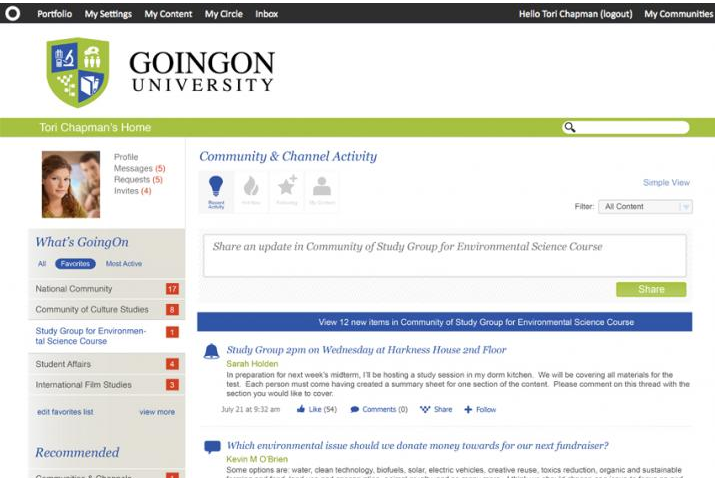Back in 2007, there were a host of companies (at various stages of development) attempting to capitalize on the growing social revolution by making it easy for people to launch their own social networks. (You can read our coverage of a few of these companies here.) One of these companies was GoingOn, which at the time of this early coverage was a “network of networks”, partnering with media companies (among others), allowing them to integrate social networks into their existing websites, a la the KickApps of old.
Fast forward to 2011, and you’ll find that GoingOn has gone academic. What does that mean? The startup has added on to its original Drupal-based, open source software solution to become an on-demand platform for academic institutions which allows them to build their own private social networks. Essentially, GoingOn wants students and faculty to be able to connect, collaborate, and learn more easily by providing self-service collaboration tools, with Facebook-style messaging, so that schools can share resources and keep students up to date about activities happening on campus.
The key for GoingOn is that its solution allows campuses to easily integrate the platform with their existing learning management (LMS) and student information systems (SIS), customizing their new social network to meet their individual needs. The virtual social network then allows campuses to create online communities like social classrooms, student study groups, and faculty committees, as well as (leveraging Drupal’s CMS tools) an easy way to publish content to individuals, groups, and communities within the network, aggregate feeds from existing LMS and SIS systems — and students can set up academic profiles, portfolios, and aggregate their classes.
The ambitious and far-reaching goal for GoingOn, CEO Jon Corshen tells us, is a large-scale platform play: To create a fundamentally new piece of the academic technology ecosystem, one that sits between and ties together LMS, SIS, and the Portal. Schools know that portals aren’t working for them anymore, most students don’t use them, but these institutions want to find ways to keep them engaged and active — to tell them what’s going on.
In the beginning, Corshen said, colleges and universities believed Facebook would be the answer, but it’s become clear that students and faculty want to separate their academic and social lives. While LMSes like Blackboard, Pearson, and Desire2Learn are said to be the answer to this, most students know that these solutions aren’t particularly appealing, and they’re built around a closed, course-centric model.
GoingOn wants to go beyond the course (and student-teacher) model, focusing on the broader academic life experience and sharing at a deeper and more integrated level. Schools today are moving to a blending and distance learning model, with students taking courses online, from all over the world, and faculties are relying more heavily on adjunct professors. So, as the mission of GoingOn is to help students, and faculty, to more effectively connect, collaborate and learn outside the context of the course, combining new models of communication with deeper analysis and recommendations can lead to more meaningful ways for students and faculty to do this.
To build these richer forms of communication, GoingOn has hired Taneli Otala as CTO. Otala is formerly CTO of Atomic Labs, MySQL AB, SenSage, Verano, and held senior positions at Oracle and many others. Since joining the startup, the open source expert has integrated technologies like Drupal, Hadoop, Cassandra, Manhout, Scale, Lift, Apache Camel, Hive, PIG, and ZooKeeper in an attempt to take GoingOn from a social learning and community management platform to a stream-based academic engagement network.
When I asked Otala what he envisions as both the future of GoingOn as well as the edtech landscape going forward, he had a very interesting (if somewhat technical) response:
The real future is in stream analysis and recommendations. On a simple level, these new academic systems need to be smart enough to know, for example, that a post about a guest lecturer in child psychology should be routed to anyone that is a psychology major (based on explicit profile fields) or by understanding what types of communities they are members of (implicit).
But to make them truly amazing, we want to get down to the semantic level to build a ‘knowledge cloud’ around people to understand what they are experts in or interested in — based on the content they are contributing (and its rating/usage) and interacting with. Whether you are a student looking for a math tutor or a top researcher looking for help in a cross-disciplinary field, networks should help you to find resources — not through generic search — but by understanding the knowledge graph in the network. Start as one school and imagine expanding across schools. This is the true future of open education resources — not simply just posting free content into a common database.
For better or for worse, GoingOn is playing on a big scale, with stream-based architecture and “modern” technologies that tend to scare the bajeesus out of academic institutions and their legacy frameworks. The academic market is challenging to say the least, especially for a software (SaaS) provider. They have an interesting concept, but it may just be too hard of a sell to really take off. That being said, the “social platform for academic life” is now serving more than twenty-five institutions, with more to come.
As to price? The company operates on a subscription model, with monthly subscriptions running from $1K and up based on the number of active users. The startup was angel-funded until it raised $7 million from Granite Ventures, Omidyar Networks, California Technology Ventures and Armada Ventures earlier this year.
For more, check out GoingOn at home here.

